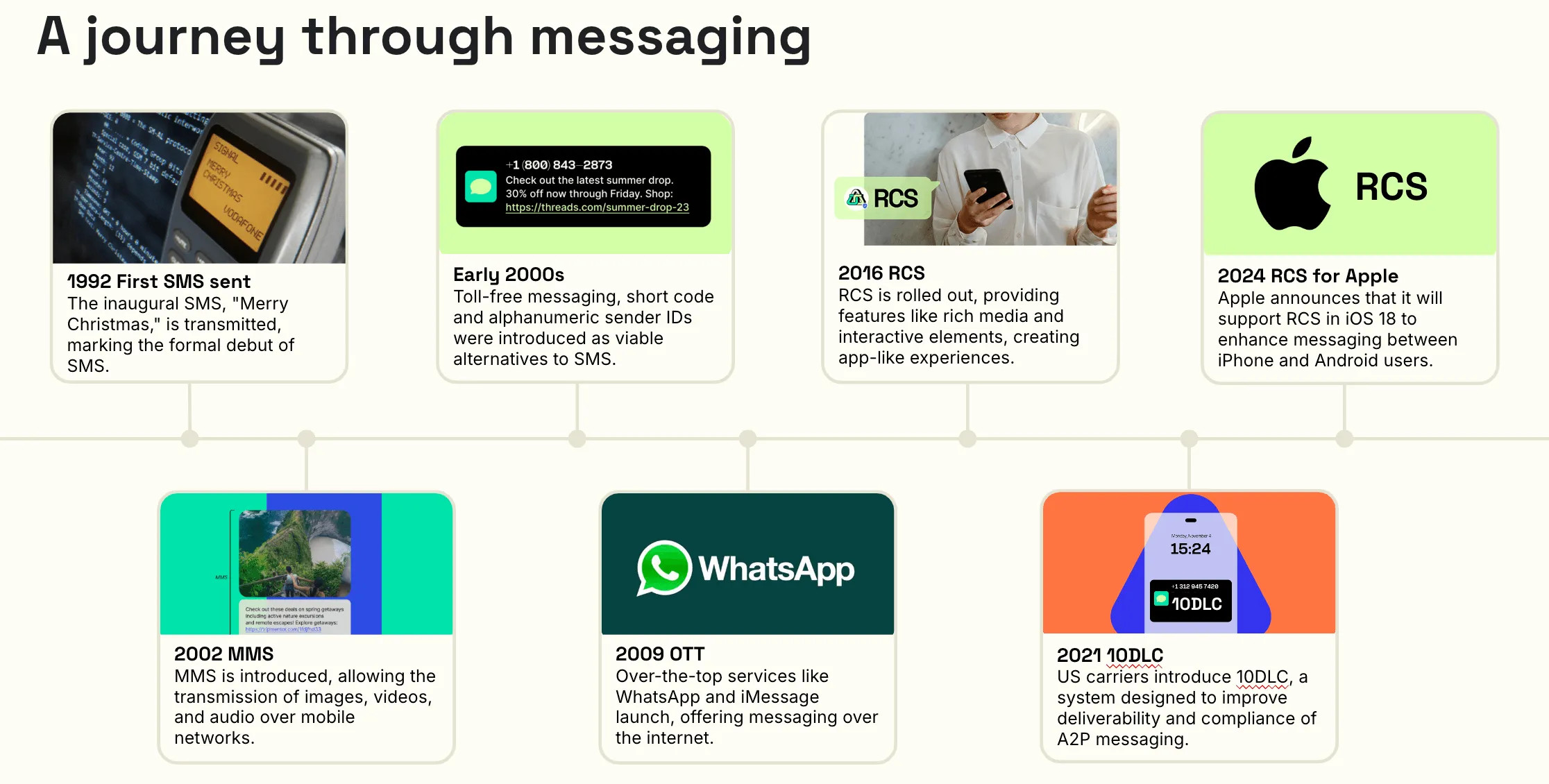
Text messaging has come a long way since the first SMS was sent in 1992. What started as a simple way to deliver 160 characters has evolved into a rich, interactive medium powering modern communication. From emojis and multimedia messaging to real-time engagement with RCS (Rich Communication Services), messaging technology has dramatically changed how people connect and how businesses interact with customers.
This post dives into the evolution of messaging, tracing its journey from SMS to RCS, exploring how each milestone has shaped the way we communicate today, and thinking about what it means for the future of messaging.
The birth of SMS
It all began on December 3, 1992, when engineer Neil Papworth sent the first-ever text message: “Merry Christmas.” This humble, 15-character message marked the start of what we now know as short message service (SMS).
Despite its limitations, SMS quickly gained popularity. By 2023, over 5 billion people globally regularly exchanged text messages. Approximately 23 billion SMS and MMS messages were sent daily, according to Expert Beacon.
Adding a little more to the message: MMS
As phones advanced, people wanted more than just words. The early 2000s saw the rise of multimedia messaging service (MMS), which allowed users to send images, audio, and videos. In the United States, the number of MMS messages sent increased from approximately 57 billion in 2009 to around 74 billion in 2012, according to Statista.
Despite these figures, high costs and compatibility issues kept MMS from reaching the same ubiquity as SMS.
Toll-free messaging, shortcodes, and alphanumeric sender IDs
As SMS became a global phenomenon, businesses began seeking ways to reach customers more effectively. Toll-free messaging emerged in the early 2000s, offering businesses a familiar format for sending and receiving messages without additional costs to their customers. Around the same time, shortcodes gained popularity for their simplicity and memorability, enabling high-volume messaging for use cases like marketing campaigns and two-factor authentication.
To further expand branding opportunities, businesses also adopted alphanumeric sender IDs. This format, which allows messages to display brand names instead of phone numbers, enhanced recognition and trust among recipients, especially in international markets.
Enter the internet: OTT messaging services
By the late 2000s, the rise of over-the-top (OTT) messaging apps like WhatsApp and WeChat changed the game. WhatsApp, launched in 2009, surpassed 2 billion active users globally by 2020, according to Statista.
These platforms offered free messaging over the internet and exciting features like group chats, multimedia sharing, and voice calls. OTT apps quickly disrupted the messaging landscape, with OTT messaging volume surpassing SMS traffic as early as 2013.
Business messaging gets smarter: 10DLC
As businesses embraced SMS as a tool for connecting with customers, they needed a solution that felt personal yet scaled efficiently. Enter 10DLC (10-digit long code), a system designed for businesses to send high volumes of messages through local phone numbers. Unlike short codes, which felt impersonal, 10DLC combined a familiar local touch with the capacity to handle large-scale campaigns, like appointment reminders or marketing promotions.
By registering campaigns directly with carriers, 10DLC ensures compliance and boosts message deliverability, protecting both businesses and their audiences from spam. It strikes a balance between trust and efficiency, making it a popular choice for businesses looking to build deeper connections through messaging.
The future takes shape with RCS
The next chapter in messaging arrived with RCS. Initially introduced in 2007, RCS took years to gain traction. Google's integration of RCS into its Messages app in 2019 marked a turning point, with over 1 billion monthly active users by 2023, according to Juniper Research.
Features like high-resolution media, read receipts, and typing indicators made RCS a modern messaging solution for consumers and businesses alike. Apple's announcement of RCS support in iOS 18 is expected to further increase adoption, potentially uniting Android and iOS users under a more seamless messaging experience.
What’s next?
While RCS has made strides, challenges remain—particularly around encryption and interoperability. As the messaging industry continues to innovate, the focus will likely shift toward enhancing security and building unified platforms that connect people and businesses in meaningful ways.
From a simple “Merry Christmas” to real-time, interactive conversations, the journey through messaging reflects how far we’ve come and how much more there is to explore. Businesses and individuals will continue to push the boundaries of what messaging can do, turning it into a tool that’s not just about communication but connection.
Contact our team of experts to enhance your messaging capabilities today!
Share on Social
Related articles
